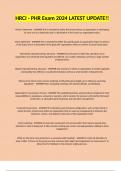HRCI - PHR Exam 2024 LATEST UPDATE!!
Mission Statement - ANSWER This is intended to define the broad mission an organization is attempting
to carry out on a daily basis and is a declaration of the reason an organization exists.
Vision Statement - ANSWER This is intended to define the specific goals an organization hopes to achieve
in the future and is a declaration of the goals the organization wishes to achieve at some future point.
Mechanistic Operational Org. Structure - ANSWER Any structure in which the operations of an
organization are extremely well regulated and defined, are usually centralized, and have a large number
of departments.
Organic Operational Org. Structure - ANSWER Any structure in which an organization is loosely regulated
and possibly less defined, is usually decentralized, and has a small number of departments.
What are the three most common methods an HR professional might use to influence upcoming
legislation? - ANSWER Mail, scheduling meetings with elected officials, and lobbying.
Organization's Governance Process - ANSWER The established policies and procedures designed to meet
responsibilities to employees, consumers, investors, and to society; the process is directed by the board
of directors, or equivalent governing body, and executive management.
Corporate Governance - ANSWER The interactive and structural configuration, such as hierarchical or
matrix formats, of personnel within an organization that are used my management to influence the
behaviors, culture, and objective outcomes of the organization itself.
Active Listening - ANSWER An important component of communication that requires paying close
attention to what is being said; it often involves making eye contact and appropriately nodding to show
engagement.
What are the three core elements to a successful staff meeting? - ANSWER 1) Invite all attendees to
share a little. 2) Focus on the group and any outcomes that might need adjustment or improvement. 3)
Allow time for feedback in the decision-making process.
, Information-rich Communication Channels - ANSWER e.g. Phone, Videoconferencing, Face-to-Face
Meetings and Presentations
Gene Dalton's Change Focus Areas - ANSWER Gene Dalton developed these four to support change
areas: 1) Generalized goals -> 2) Specific objectives, formal social ties -> 3) New relationships, self-doubt
-> 4) Heightened self-esteem, and external motives for change -> 5) Internal motive for change
Lewin's Change Management Model - ANSWER 1. Unfreezing - Values, attitudes, and behaviors are
challenged, and people understand the need for change.
2. Changing - Occurs during the action phase, whereby the situation is examined, and a new equilibrium
is created.
3. Refreezing - Changes is stabilized and new patterns are solidified.
McKinsey 7-S Model - ANSWER 1) Strategy
2) Structure
3) Systems
4) Shared Values
5) Style
6) Staff
7) Skills
John Kotter's 8-Step Change Model - ANSWER 1) Create a sense of urgency.
2) Build a guiding coalition.
3) Develop a shared vision and strategy.
4) Communicate the change vision.
5) Empower action.
6) Generate short-term wins.
7) Capitalize on momentum.
8) Make the change stick.
, Action Research Model - ANSWER A strategy of Organizational Development (OD) that typically involves
the processes of problem identification and its reliance on data gathering and analysis to solve problems.
The model has six basic steps after the problem is recognized: 1. Data gathering 2. Feedback of data to
the target group (those involved with the problem) 3. Data discussion and diagnosis 4. Action Planning 5.
Action 6. Recycling or starting the process over.
Two-Way Change Communication - ANSWER This provides employees with the opportunity to ask
questions within the change process, repeat communications outward, then explain how employees will
be kept informed throughout the process to manage expectations.
Driving Forces of Change vs. Forces Resisting Change - ANSWER Driving Forces of Change: New
technology, desire for alternative work schedules, and new knowledge or values, as well as
environmental factors such as competition, customer demand, and available resources.
Forces Resisting Change: Individual resistance (such as fear of the unknown or distrust of management)
and organizational resistance (such as systems, relationships, or threat to power structure).
Risk Management - ANSWER The process of identifying, analyzing, and prioritizing risks or potential
uncertainties while developing strategies to protect the financial interests of a company. The goal of risk
management is to mitigate the costs of these uncertainties as much as possible.
What are the four types of risks? - ANSWER Hazard Risk - Liability or loss of property and is generally
mitigated by insurance (e.g. workers comp, fires, natural disasters, etc.)
Financial Risk - Potential negative impacts to a firm's cash flow (e.g. a major customer not paying
invoices on time.)
Operational Risk - The impact to a firm's ability to function effectively and may include technology
failures, process breakdowns, and human error.
Strategic Risk - A firm's plans becoming outdated due to shifts in the economy, politics, customer
demographics, competition, etc.
Quantitative Risk Assessment - ANSWER allows the business to assign actual dollar amounts to each risk
based on value, exposure, single loss expectancy, annualized rate of occurrence, and annualized loss
expectancy.




